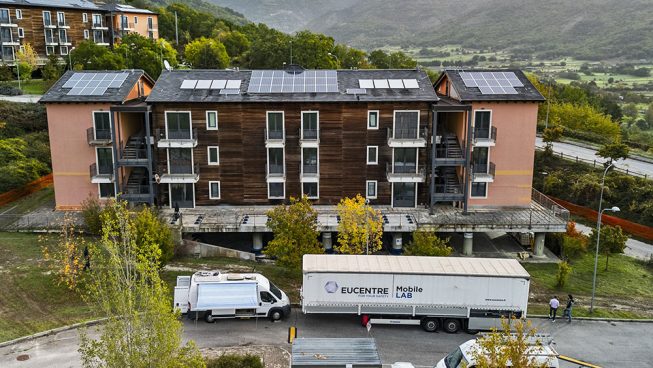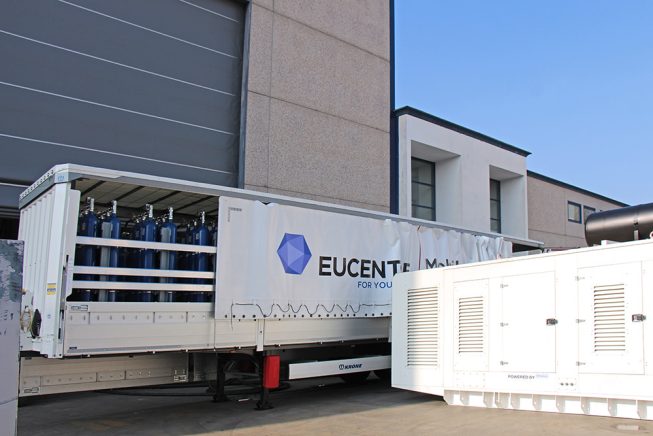The Mobile Lab is one of the flagship facilities of the Eucentre Foundation: a mobile laboratory designed to bring an experimental laboratory directly into the field. Created to perform dynamic tests in situ, Mobile Lab is a completely autonomous system that can operate anywhere, without the need for fixed support structures.
This incredible flexibility has been made possible by a sophisticated architecture, featuring an articulated truck that houses pumps, tanks, storage units, and rigid distribution lines. A power generator and a digital controller complete the system, allowing the tests to be managed independently.
Cutting-edge technology
Part of the Mobile Lab is a set of high-performance hydraulic actuators that enable controlled forces and displacements to be applied to real structures, such as buildings and bridges, or the ground.
Here are some numbers that tell the story of the power of this lab:
- Can generate displacements of up to ±250 mm
- Reaches a maximum speed of 700 mm/s
- Can apply accelerations of up to 1.0 g on 400-ton specimens.
- Maximum dynamic force of 3600 kN
- Can operate on test masses of up to 1000 tons.
- Has a system that handles up to 6000 liters of oil per minute, with an operating pressure of 280 bar.
These data confirm that the Mobile Lab is a unique tool, capable of realistically reproducing the seismic stresses acting on a structure, thus offering an extraordinary opportunity to study the in-situ response of buildings.
A pioneering experiment
A concrete and recent example of the use of Mobile Lab is the test carried out in Arischia, a suburb of L’Aquila, on one of the buildings constructed after the 2009 earthquake. In this test, which has never been carried out before, an existing building weighing approximately 2,000 tons was subjected to a series of dynamic tests.
This is a pioneering achievement: until now, tests of this kind were mainly carried out on small- to medium-sized specimens using shaking tables in experimental laboratories. For the first time, however, it was possible to perform seismic tests on a real building in situ, marking a significant step forward in seismic risk research and management.
Thanks to Mobile Lab’s hydraulic actuators, it was possible to apply controlled vibrations safely and precisely, simulating the effect of an earthquake. During the experiment, valuable data were collected on the state of the 32 seismic isolators, including displacements, accelerations, and deformations, which are essential for assessing the residual safety of the structure and planning any necessary reinforcement work.
Benefits for seismic prevention and safety
Thanks to Mobile Lab, engineers and designers can rely on real data rather than just numerical simulations. This experimental approach reduces uncertainty and enables them to design more effective interventions, optimising resources and time.
In-situ tests, such as the one in Arischia, are a fundamental building block for building safer and more resilient cities. The Mobile Lab helps to protect not only buildings but also historical and cultural heritage.
Eucentre’s commitment to societal resilience
The work of the Eucentre Foundation has always been oriented towards applied research and the dissemination of advanced technologies for reducing seismic risk. Mobile Lab is the most concrete proof of this: a combination of technology, mobility, and innovation that brings research into the field and puts it at the service of people’s safety.
 Eucentre is a non-profit private law foundation whose mission is to conduct research and provide training and services in earthquake and safety engineering
Eucentre is a non-profit private law foundation whose mission is to conduct research and provide training and services in earthquake and safety engineering  Eucentre promotes science, research and innovation for the benefit of the community, offering targeted methodologies and concrete solutions for prevention, safety and resilience. It collaborates with institutions and companies to disseminate competencies for the common good.
Eucentre promotes science, research and innovation for the benefit of the community, offering targeted methodologies and concrete solutions for prevention, safety and resilience. It collaborates with institutions and companies to disseminate competencies for the common good. Shake-tables
Shake-tables Other test systems
Other test systems Eucentre carries out research activities in earthquake engineering and risk reduction through laboratory testing and numerical analysis, aiming to improve the seismic performance of structures and soils and to develop innovative seismic retrofitting techniques.
Eucentre carries out research activities in earthquake engineering and risk reduction through laboratory testing and numerical analysis, aiming to improve the seismic performance of structures and soils and to develop innovative seismic retrofitting techniques. The Foundation promotes diverse and high-quality training activities aimed at academic and professional contexts, with constantly updated and innovative programs and initiatives designed to meet the evolving needs of the sector and society
The Foundation promotes diverse and high-quality training activities aimed at academic and professional contexts, with constantly updated and innovative programs and initiatives designed to meet the evolving needs of the sector and society  Eucentre ensures communication aimed at informing institutions, professionals, and citizens about ongoing activities and projects, with the goal of disseminating useful and accessible content and knowledge. It contributes to promoting a shared and informed culture of prevention and resilience.
Eucentre ensures communication aimed at informing institutions, professionals, and citizens about ongoing activities and projects, with the goal of disseminating useful and accessible content and knowledge. It contributes to promoting a shared and informed culture of prevention and resilience.

